Clancy Tucker's Blog, page 29
January 16, 2022
2 March 2022 - SHOES ON THE DANUBE PROMENADE - HUNGARY
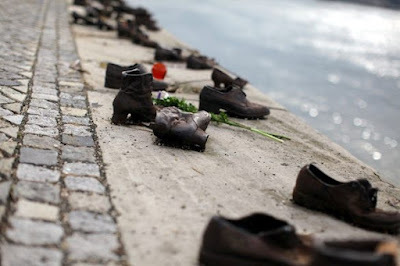
SHOES ON THE
DANUBE PROMENADE
- HUNGARY -
G'day folks,
A trail of iron footwear stands as a monument to the thousands executed along this riverbank during WWII.In October of 1944, Hitler overthrew the leader of the Hungarian government, Miklos Horthy, and replaced him with Ferenc Szalasi.
Szalasi, whose ideology closely followed Hitler’s, immediately established the Arrow Cross Party - a fascist, anti-semitic organization that brutally and publicly terrorized the Jews in Budapest by beating and killing them. Nearly 80,000 Jews were expelled from Hungary in a death march to the Austrian border and approximately 20,000 Jews were brutally shot along the banks of the Danube River. The victims were forced to remove their shoes at gunpoint (shoes being a valuable commodity during World War II) and face their executioner before they were shot without mercy, falling over the edge to be washed away by the freezing waters.
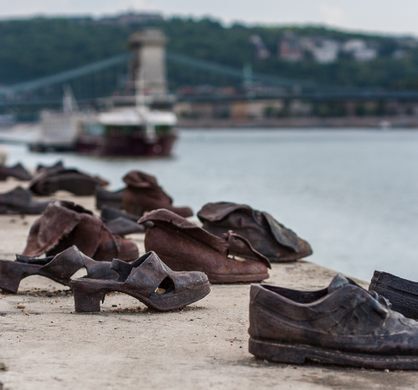
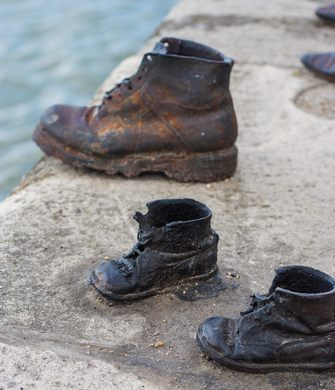
Shoes on the Danube Promenade is a haunting tribute to this horrific time in history, created by film director Can Togay and the sculptor, Gyula Pauer. Installed along the bank of the Danube River in Budapest, the monument consists of 60 pairs of 1940s-style shoes, true to life in size and detail, sculpted out of iron.
This memorial is simple yet chilling, depicting the shoes left behind by the thousands of Jews who were murdered by the Arrow Cross. The style of footwear - a man’s work boot; a business man’s loafer; a woman’s pair of heels; even the tiny shoes of a child - were chosen specifically to illustrate how no one, regardless of age, gender, or occupation was spared. Placed in a casual fashion, as if the people just stepped out of them, these little statues are a grim reminder of the souls who once occupied them - yet they also create a beautiful place of reflection and reverence.
At three points along the memorial are cast iron signs with the following text in Hungarian, English, and Hebrew: “To the memory of the victims shot into the Danube by Arrow Cross militiamen in 1944–45. Erected 16 April 2005.”
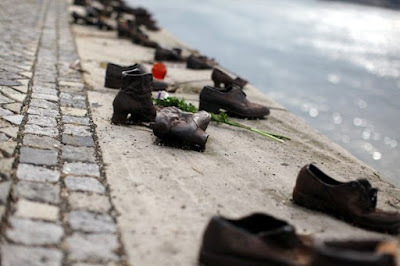
Clancy's comment: Lest we forget.
I'm ...


January 15, 2022
1 March 2022 - BERTHA'S BEACH - FALKLAND ISLANDS
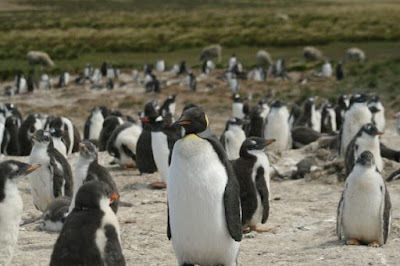
BERTHA'S BEACH
- FALKLAND ISLANDS -
G'day folks,
This remote stretch of sand is a penguin lover's paradise.This beach is named after the Bertha ship that wrecked on the beach, though the wreck is no longer visible. But a lost shipwreck isn’t its only draw. If you’re a keen birder, this stretch of sand is a must-see.
Bertha’s Beach is classed as both an important bird area and a Ramsar Wetland site because of the various birds that call it home. Head to the beach, and you’ll likely spot penguins waddling around.


A number of Gentoo penguin colonies live on the beach year-round. For about half the year, it’s also frequented by Magellanic penguins. In addition to the penguins, the beach is also home to South American terns, ruddy-headed geese, the endemic Falkland flightless steamer duck, and various other birds.
Although not as reliable as the bird watching, you can often see both Commerson’s and Peale’s dolphins playing and hunting in the surf of the beach. Sometimes the dolphins come close to the shore and essentially surf in the shallows to catch fish before returning to the waves. Although rare, if you are very lucky, you may be able to see beaked, toothed, baleen, or killer whales swimming by.
Additionally, various types of sea lions and seals often come ashore to bask on the beach. The majority of them are harmless, but the leopard seals have been known to bite people who get too close to them.
The flora is just as interesting as the fauna. The beach is also home to over 80 types of plants, with five of them being endemic and the Dusen’s moonwort ferns being very rare.
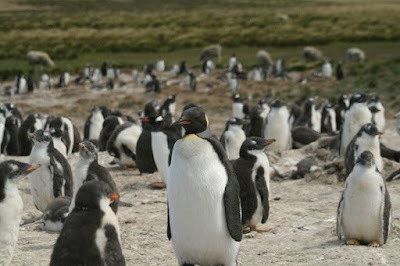
Clancy's comment: A great place to photograph wildlife.
I'm ...


January 12, 2022
17 March 2022 - LESSONS LEARNT FROM THE 1918 FLU PANDEMIC
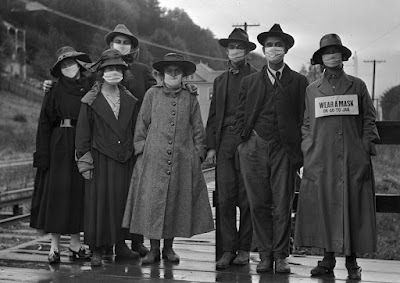
LESSONS LEARNT FROM
THE 1918 FLU PANDEMIC
G'day folks,
Brevig Mission is a tiny ocean-side settlement in Alaska which, in 1918, had 80 adult inhabitants. During the five-day period starting November 15, 1918, 72 of them were killed by the influenza pandemic then raging across the world.
It is significant for two reasons. First, the number of deaths in the village shows the ferocity and extensive reach of this epidemic. Second, because the victims were buried (and preserved) in permafrost conditions scientists were able, years later, to study the virus in detail.
It is estimated that 40 million people died in the First World War between 1914 and 1918. In that final year of the war the great influenza pandemic took hold and was to cause possibly 50 million fatalities, some estimates claiming a global death toll as high as 100 million.
No pandemic before or since has resulted in deaths on such a scale. Tragically, many soldiers who survived the horrors of trench warfare then fell victim to the influenza scourge.
It is commonly referred to as “the Spanish flu” epidemic but Spain is highly unlikely to have been the source. Wartime censors in the UK, Germany, the United States and France, anxious not to lower morale, played down the numbers of victims. But there were no restrictions on reporting the figures for Spain, which had taken no part in the war. So the belief grew that seemingly badly hit Spain was the epicentre of the disease.
The 1918 pandemic came in three waves. During the first, in the early part of the year, deaths were relatively low. The second wave, which began in August, was much more serious, the virus having mutated to a considerably aggressive form and October was the deadliest month of the whole pandemic.
Those between the ages of 20 and 40 were the most vulnerable, the virus so savage that a victim might show no symptoms in the morning but be dead by nightfall.
The third wave in the spring of 1919 was more lethal than the first but less so than the second.
An unusual characteristic of the virus was the high death rate among healthy young adults. But after the lethal second wave peaked in late 1918 new cases of infection dropped abruptly and the virus eventually burnt itself out.
Many factors contributed to the virulence of the 1918 pandemic. The world was at war and large numbers of troops stayed in close contact. No diagnostic tests existed; in fact, doctors didn’t know flu viruses existed.
Even if they had known, vaccines did not exist, antibiotics had not been invented and no antiviral drugs were available. On top of that, there was no such thing as intensive care or mechanical ventilation.
Businesses, though, were not slow to offer so-called remedies. Products including Lifebuoy soap, Oxo, Aspirin, quinine, opium, turpentine, iodine, ammonia, cinnamon, cocoa, disinfectant and even cigarettes were all promoted as having properties that could either prevent the flu or ward it off.
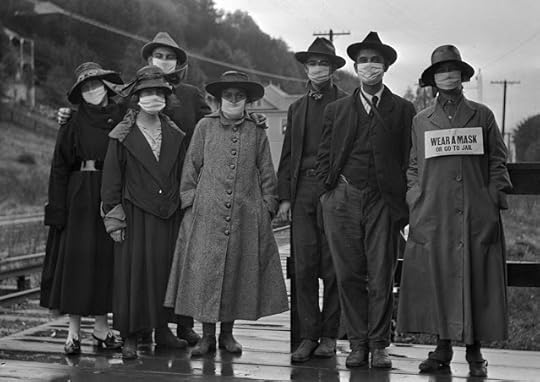
As the years passed, scientists were keen to discover the virus’s secrets so that new vaccines and treatments for future pandemics could be developed.
In 1951, Johan Hultin, a 25-year-old Swedish microbiologist, went to Brevig Mission hoping to find traces of the virus frozen within the tissues of villagers buried there. He failed, but returned 46 years later in 1997 with other scientists and unearthed the remains of a woman, aged about 30, whom he named “Lucy”.
Traces from “Lucy’s” lungs allowed researchers to completely analyse the critical gene structures of the 1918 virus, revealing that it originated in birds and mutated to infect people.
Scientists called it “an H1N1 virus with genes of avian origin."
Three more pandemics would occur before Coronavirus would send the world spinning in 2020. They were: the 1957 H2N2 pandemic “Asian flu” causing 1.1 million deaths worldwide; the 1968 H3N2 pandemic “Hong Kong flu” with 1 million deaths; and the 2009 H1N1 pandemic "swine flu” with up to 575,000 deaths.
Putting it all in perspective, according to America’s Centers for Disease Control and Prevention, the “flu season” in the United States generally runs from late fall into spring. In a typical year, more than 200,000 Americans are hospitalised for flu-related complications, and over the past three decades there have been up to 49,000 flu-related deaths annually.
The question remains as to whether a devastating pandemic on the scale of 1918 could occur in modern times. Many experts think so.
Richard Gunderman, Professor of Medicine at Indiana University, wrote in the Smithsonian Magazine in 2020:
“For the foreseeable future, viral epidemics will remain a regular feature of human life.
“But today scientists know more about how to isolate and handle large numbers of ill and dying patients, and physicians can prescribe antibiotics, not available in 1918, to combat secondary bacterial infections. To such common-sense practices as social distancing and hand-washing, contemporary medicine can add the creation of vaccinations and anti-viral drugs.
“As a society, we can only hope that we have learned the great pandemic’s lessons sufficiently well to quell the current Covid-19 challenge.”
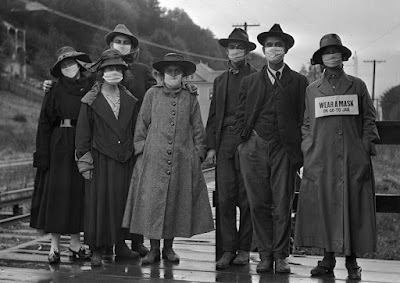
Clancy's comment: Mm ... have we really learnt anything? I doubt it. As I write this, 94,000 people have caught Covid 19 in one state of Australia ... in the past 24 hours.
I'm ...


January 6, 2022
27 February 2022 - AN ISLAND WITH FIVE RESIDENTS - ICELAND
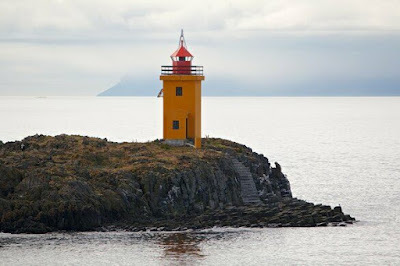
AN ISLAND WITH
FIVE RESIDENTS
- ICELAND -
G'day folks,
Once the site of a 12-century monastery, this tiny island is now home to only five permanent residents.Located in the bay of Breiðafjörður, the small, windswept island of Flatey is often overlooked by travelers. But despite being only two kilometers (1.2 miles) long and one kilometer (0.6 miles) wide, this tiny speck of land boasts a surprising wealth of culture, history, and natural beauty.
A former monastery was founded on the island in 1172, and it long served as the resting place for an important medieval manuscript known as Flateyjarbók. Flatey later received a trading license from the Danish Crown in 1777, sparking an increase in island residents. Toward the end of the 19th century, however, most left to seek opportunities off the small island.
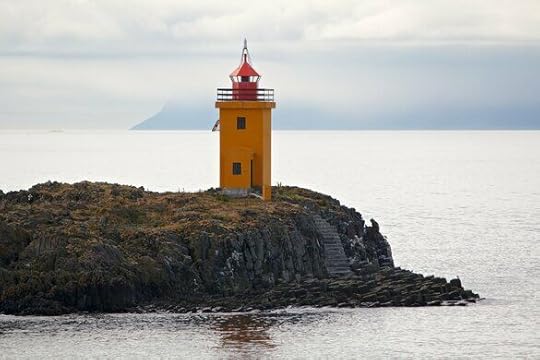
According to a June 2020 article on Traveo, only five people live on Flatey throughout the year. Given that fact, Flatey is not well-catered to mass-tourism—though it is popular with those who stay on the island over the summer—and has only modest offerings when it comes to entertainment. Those looking for a “thrilling” night might try bingo at Frystihúsið (“The Freezer”) cafe.
Built in 1926, a small white church is Flatey’s most prominent landmark, and its steeple marks the highest point on the island. This, however, is not particularly impressive, considering Flatey takes its name (“flat island”) from its low-lying meadows and bays. The interior of the church was decorated by the painter Baltasar Samper and shows scenes of the island’s past fishermen and farmers.
The rest of Flatey’s architecture has remained almost entirely unchanged since the late 19th century. With their peeling paint jobs and corrugated iron rooftops, the island’s historic homes give off either a quaint or eerie feel, depending on the weather.
During the summers, the lush green beauty of Flatey is readily apparent outside of its village: Atlantic puffins swoop in the sky, unshorn rams strut in the fields, and skeletal shipwrecks are left to wither away on the shoreline. It is a place where nature still reigns supreme, with particular allure for those guests in Iceland looking to truly get away from it all.
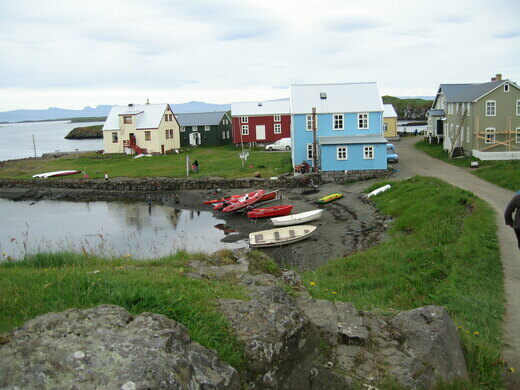
Clancy's comment: Looks like a great place to fish ... and write books.
I'm ...


January 4, 2022
26 February 2022 - ANCIENT ETCHINGS AT PIKE'S GUT - FINLAND
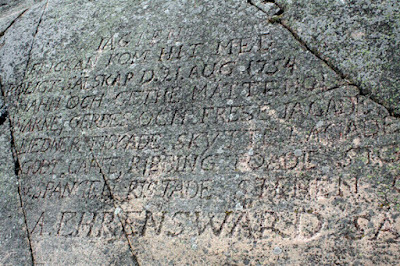
ANCIENT ETCHINGS
AT PIKE'S GUT
- FINLAND -
G'day folks,
The etchings on this narrow channel between two islands bear witness to maritime travelers who have passed through since the Middle Ages.Just off the southernmost tip of the Finnish mainland sit Tullholmen and Kobben Islands. Huddling close to one another where the Gulf of Finland meets the Baltic Sea, the islands are separated by a narrow strait that is home to a unique collection of graffiti stretching back over half a millennium.
Pike’s Gut (“Hauensuoli” in Finnish) has served for centuries as a safe haven for seamen awaiting good weather conditions or favorable winds. Sometimes, however, the wait could last for weeks, so to pass the time the sailors came ashore and carved farewell notes, their names and coats of arms on the rocky faces of these islands. The oldest dates back to the 15th century, though most of the extent carvings are from the 16th and 17th centuries.



Over time the word spread about this “guest book of the archipelago”, attracting even more people to visit and add their own marks. Over 600 such carvings have been identified.
Due to exposure to the elements and the considerable age of the graffiti, the markings have worn off and are not easy to see. In 1967 the local community was called to donate their used toothbrushes so the rocks could be cleaned of lichen and dirt. Later the lines were filled with dark color so the markings would be more visible. Nearby shipwrecks also speak to the location’s significance as a cultural and historical site. It is a protected area under Finland’s Antiquities Act and is under the care of the National Board of Antiquities.

Clancy's comment: I always find these fascinating. Many of these would have taken considerable work to produce.
I'm ...


5 January 2022 - RICHARD THE LIONHEART - THE STRANGER KING
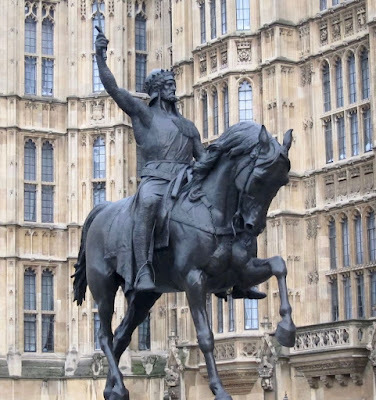
RICHARD THE LIONHEART
- THE STRANGER KING -
G'day folks,
When it comes to warrior kings, few tick as many boxes as Richard I of England who died in 1199.
Even now, as though still defending the realm, he sits astride his horse outside the Houses of Parliament in London, sword raised aloft, defiant, muscular, formidable.
This was the king for whom a nobleman of folklore gave up his title and lands to become the outlaw Robin Hood, living in a forest, stealing from the rich and giving to the poor as he defended the interests and legacy of his beloved monarch who was away fighting in the Crusades.
And yet . . . in the whole of his reign from 1189 this iconic English king spent no more than a total of six months in the country. If he was not off fighting in the Crusades, he was in France defending his castles and other extensive interests there.
Neither of his parents were English and there is some doubt that Richard, born in 1157, ever learned to speak the language of his subjects.
There is certainly no doubt about his courage, though. He liked a good scrap and relished his role as leader of the Third Crusade (1188-92) against the Saracens under Saladin, the Muslim leader of Egypt and Syria. Richard’s avowed aim was to capture Jerusalem and restore Christianity to the Holy Land.
Some historians believe, though, that the king was really more interested in grabbing the gold and vast treasure on offer there.
For it has been claimed that in truth Richard was greedy, violent and ruthless. Historian William Stubbs described him as “a bad son, a bad husband, a selfish ruler and a vicious man.”
His cruel streak came to the fore in 1191 when his forces attacked and took control of the city of Acre in the Kingdom of Jerusalem. More than 2,700 prisoners were taken and Richard ordered that they should all be put to death. He sat and watched from a balcony as the executions took place.
The Crusade was unsuccessful and when it came to an end Richard’s thoughts turned towards home.

But he had a problem. Having insulted and alienated many of his French and German Christian allies in the Crusade, none were willing to help him return and he was reduced to trying to make it in disguise.
He was caught and imprisoned by the Emperor of Germany who demanded a colossal ransom of 150,000 marks – truly a king’s ransom.
Richard’s mother, Queen Eleanor, led the taxation drive and fund-raising effort to have her son freed, campaigning across the empire on behalf of “Good King Richard”.
But a month after arriving “home” in England, the seemingly ungrateful Lionheart left for France, never to return.
It seems it was his greed that led to his early death at the age of 41. A French nobleman whose land was under Richard’s control refused to hand over a hoard of gold that had been unearthed by a peasant.
The king promptly laid siege to the man’s castle and was fatally wounded by a crossbow in the fighting. He was buried in France.

Clancy's comment: An Engish king buried in France. Who'd have ever imagined that?
I'm ...


January 3, 2022
24 February 2022 - BENGTSKAR LIGHTHOUSE - FINLAND
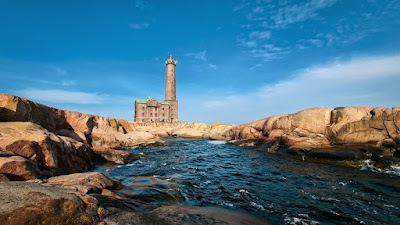
BENGTSKAR LIGHTHOUSE
- FINLAND -
G'day folks,
The tallest lighthouse in the Nordic countries was also the site of a bloody World War II battle.Countless shipwrecks littered the sea in Finland’s western archipelago during the late 1800s and early 1900s. On New Year’s Day in 1905, a newly constructed steamship became the latest vessel to succumb to the shallow waters.
In 1906, construction on a lighthouse to aid travel along the trade route began in haste. In a mere nine months, the lighthouse was erected and composed of granite and bricks. It was lit for the first time on December 19, 1906.

Workers and their families who remained in the area maintained the lighthouse and worked in shifts handling the light and foghorns. The wives tended to the living quarters and taught the children in a small school.
When World War II erupted, Finland was forced to defend Bengtskär. The island’s location not only served well for guiding ships through the labyrinth of islands, but it also was a safeguard from attacks by way of the Gulf of Finland. It’s importance led to Russia launching an invasion of the island.
Approximately 35 Finnish soldiers were stationed on the island. When the invasion began, the radio operator on the island called for support. Within minutes, the coastal artillery team began firing. Within hours, navy ships and planes converged on Bengtskär. When the battle was over, the Finns had secured the island.
The next day, Soviet forces bombed the lighthouse.
When it was all said and done, the Soviet Union pulled out from the Hanko region and Finland regained control of its lands and water. About 32 Finnish soldiers and 60 Russian soldiers were killed in the short Battle of Bengtskär.
After the war, the lighthouse was mostly left to deteriorate. Restoration efforts did not begin until 1992. It took three years to renovate the structure. In 1995, the island opened as a museum to the lighthouse and its wartime history.
The old apartments in which the lighthouse keepers and their families lived have been converted into hotel rooms.
Deep window seals running up along the spiraling, steel staircase contain small exhibits and artifacts paying homage to the island’s dramatic past. A military bunker and other war relics can still be explored on the island.
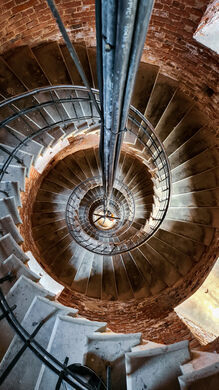
Clancy's comment: I'd love to visit it and take photographs.
I'm ...
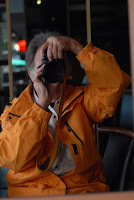

January 2, 2022
19 February 2022 - CLINTON 12 STATUE - TENNESSEE
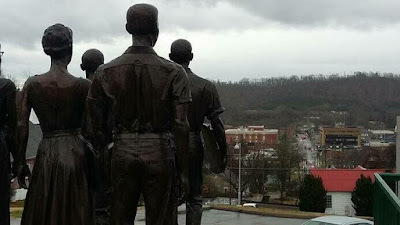
CLINTON 12 STATUE
- TENNESSEE -
G'day folks,
A bronze sculpture honors the 12 black students who attended the first integrated public high school in the segregated South.High on top of a hill overlooking the small East Tennessee town of Clinton, 12 bronzed statues of high school students stand in front of an old school building. They are symbols of courage and conviction in an age of racial strife.
In August of 1956, 12 black students walked down the hill from this school into an all-white public high school for their first day of classes. This marked the first integration of a public high school in the segregated South.
The groundbreaking event came in the wake of the landmark Supreme Court decision of Brown vs. Board of Education. The integration of Clinton High School is often overshadowed by what happened in places like Little Rock, Arkansas a year later. The events here made national news at the time, but were mostly “forgotten” until 2006 when a documentary on the “Clinton 12” was released and the Green McAdoo Cultural Center opened its doors.
For the most part, the situation in 1956 remained calm and peaceful. However, outside agitators made a scene and the National Guard tanks eventually rolled across the Clinch River bridge to help keep the situation from turning violent. Today, the story of the Clinton 12 is told in the old Green McAdoo School, the place where these students attended elementary school. Black students in Clinton could not attend high school in the county and had to travel to the nearest public black high school 30 miles away in Knoxville.

When you step inside the museum there are school desks set up in rows. You can take a seat and soak in your surroundings, getting a good idea what it must have been like to go to school there. Continuing through the museum, large displays explain what happened when John Kasper came to Clinton and the trouble he caused. You also learn how the actions of a Baptist Minister and a high school football captain each worked to make the Clinton 12 feel welcome in their new surroundings.
Probably the most moving section focuses on the bombing of the high school (now Clinton Middle School). Luckily, it happened after-hours and no one was injured or killed, but it did force an already stressed student body to have to pack up and move until a new school was built. A historical marker now stands in front of Clinton Middle School, marking the historic events of the time.
The story of the Clinton 12 is also told in a special Disney Channel production made for Black History Month. It features actor Cameron Boyce telling the story of his grandmother, JoAnn Boyce, who was one of the original 12 students.
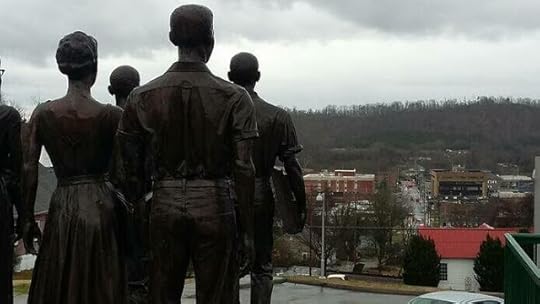
Clancy's comment: Twelve courageous students.
I'm ...


23 February 2022 - TALASEA AIRSTRIP - NEW GUINEA

TALASEA AIRSTRIP
- NEW GUINEA -
G'day folks,
Two World War II aircraft lie within the jungle around this abandoned runway.The South Pacific is littered with relics leftover from World War II. Military tunnels snake beneath tiny towns. Planes and equipment lie sunken beneath the water, cloaked in coral. Dense tangles of jungle hold more forgotten wartime treasures, like this abandoned airfield.
Originally built by the Australian army as a small landing strip, Talasea was occupied by both the Japanese and Americans during the second World War, changing hands between them. Too small to accommodate fighter planes, the airfield was used as an emergency landing strip in the later part of the war.
In early September 1944, the landing strip saw its final pieces of action. On September 3, 1944, an American B-25H bomber took off from Stirling Island with the objective of locating and destroying any remaining Japanese ships of the South Coast of New Britain. While the mission was a success, the B-25H aircraft incurred engine trouble, and rather than risk the flight back to its base, the captain made the decision to make an emergency landing at Talasea.
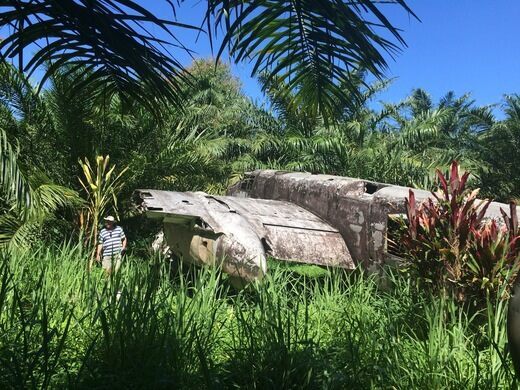
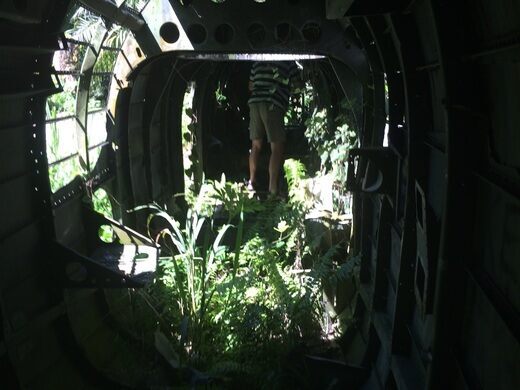
In a similar mission less than a week later, a Lockheed Ventura was dispatched to bomb a Japanese-occupied airstrip near Rabaul. The Lockheed’s mission was successful, but one engine failed on the return journey. As the crew knew the plane wouldn’t make it all the way back to base, they too made the decision to land at Talasea.
Shortly after the war ended, the airstrip at Talasea was abandoned. Palm oil plantations sprung up around Talasea in the 1960s, and nature gradually encroached around the planes. Today, the airstrip is virtually unrecognizable from its former runway glory.
The land still holds tidbits of its wartime past, however, as both the B-25 bomber and Lockheed remain in their final resting places. While exploring on foot, make your way through the overgrown bush, and you’ll reach the B-25H bomber, resting on its undercarriage atop a bed of lush greenery.
Fewer than 40 yards to the west lies the Lockheed Ventura. With the Allied star still barely visible on its side, you can still walk inside the plant-filled undercarriage and imagine the tight spaces where the pilots and crew would have sat.

Clancy's comment: History lying in-state.
I'm ...


January 1, 2022
28 February 2022 - THE SPANISH FLU
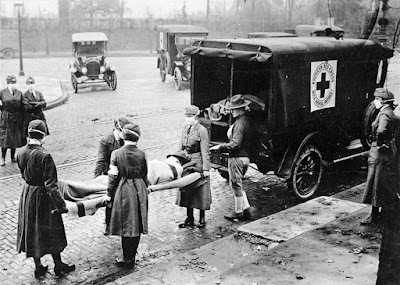
THE SPANISH FLU
G'day folks,
This will sound familiar.
In 1918, the world was ravaged by twin catastrophes. World War I was entering its climactic phase, after four years of calamity, as Allied armies advanced across Europe to fight the Central Powers. At the same time, a much smaller enemy was beginning to ravage cities and towns across the globe.
Nobody is quite sure where the deadly strain of influenza virus that spread like wildfire in 1918 came from. What is known is that the pandemic killed between 17 and 50 million people, and possibly as many as 100 million, making it one of the worst catastrophes in human history.
There were two main waves of the pandemic. The one in early 1918 was similar to seasonal influenza, in that the elderly and those with underlying health conditions were most at risk. But by August, the H1N1 virus had mutated to a far deadlier form.
There are competing theories as to why the second wave of the disease was so deadly for young people. One explanation is that it caused what is known as a 'cytokine storm', where the immune system goes into overdrive to fight the virus and ends up causing pneumonia and raising the risk of mortality. In this case, a stronger immune system would have been a liability.
The other theory is that poor hygiene standards in 1918, the lack of a vaccine and many people across the world being malnourished due to the effects of war, plus rapid spread facilitated by the movement of vast numbers of troops during World War I's closing stages were primarily to blame for the enormous death numbers.
The 'Spanish flu' was named such not because it originated in Spain, but because of wartime censorship. Newspapers were not allowed to report extensively on mortality in Allied countries, but Spain was neutral, so they could report on the effects there, thus giving the impression that Spain was particularly badly hit by the flu.
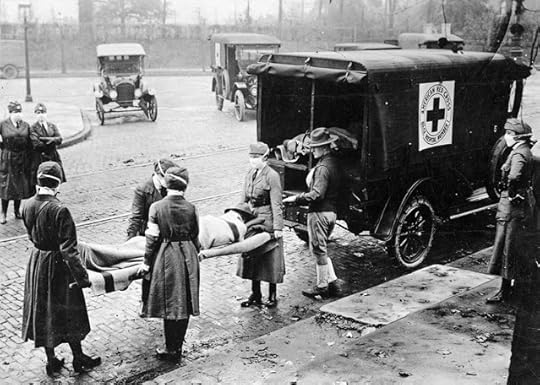
Clancy's comment: Mio dio!
I'm ...





